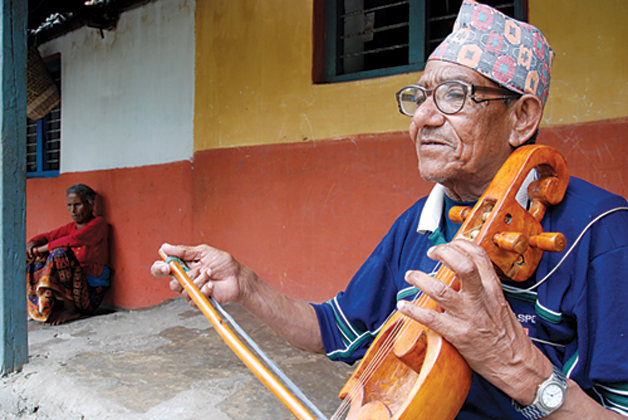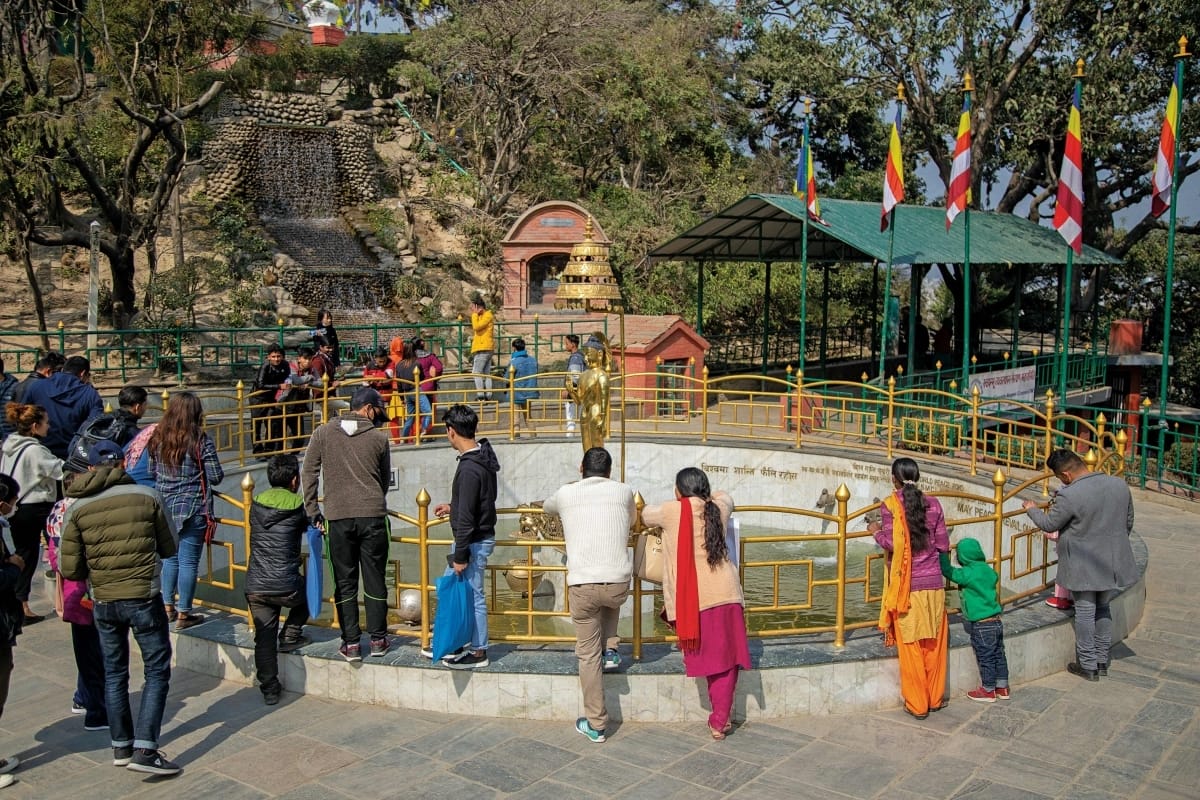How can one sum up a meeting with Khim Bahadur? Is it like visiting a ‘cultural museum of important lasts’? Or taking a step back, away from this time or yuga?
Then again, it could be just like going to meet an incredibly talented musician. In fact, it is all of the above and much more. Those who do not know of him are probably, at this point, wandering, “so who is Khim Bahadur Gandarbha?”
Away, out in the back of Pokhara town at a place called Batulechaur, is a deep gorge that feels endless with steps cut out that head down into a deep, dark, black mass, topped with vivid green grasses, making a vibrant contrast… much like the effect of an artist who uses a black canvas. Below is a quaint congregation of simple houses and cabins. The walk down reminded me of a place where I might see honey hunters dangling from ropes far overhead. Instead, in this hamlet, I met a man, an old man, a well-travelled man, a talented musician, a revered teacher.

Meet Khim Bahadur, the last living Gandarbha teacher.
What’s a Gandarbha? And well you ask. It’s a caste, one of the countless castes or groups of people so intricately interwoven into the society of Nepal. One may also say that they are traditionally a landless caste of wandering Gaines or ‘minstrels’ who play the sarangee, that ubiquitous violin-like instrument found throughout the villages and towns of Nepal, and on Thamel’s chaotic streets. Back in the time of Nepal’s traditional caste system, the livelihoods of the Gandarbha men and their families were completely dependant upon their instruments and abilities as a Gaine. Back then, a Gandarbha who didn’t live by the sarangee could not even marry the daughter of another Gandarbha, so says Khim with a subtle look of sad nostalgia on his face as he tells me about his life and the ways of his people – the Gandarbhas.
In The ‘Before Time’
Born in 1992 (2066 BS as per the Nepali calendar), Khim is now 74 years old, or so he reckons. When he was just two years old, his father passed away and so was raised by his mother with support from local relatives. It was his paternal uncle who gave him the sarangee when Khim was seven, making him practice it for two hours every day, thus arming him with the necessary ‘tool’ for survival. Those were tough times, he recalls. Everything in a Gandarbha’s life revolved around the sarangee – everything.
At the age of 13, Khim went on a tour to India with some friends. While there, having naturally travelled with his sarangee, he played for the local expatriate Nepali community. So impressed were they by this young man’s abilities that they asked him to stay in India and join their own traditional band. He did so for about two years until he received word through the authorities that his relatives and friends were worried, not knowing if he was still alive or dead. At that, Khim packed his sarangee and bag and hit the road (as a Gandarbha does), back to Batulechaur at the foot of the mountains.
A while after his return to family and friends, he moved to Chitwan as a sukumbasi (a landless squatter or refugee as he calls it) where he lived for 22 years. In those days, Chitwan was not the pampered tourist haven it is today. A man had to literally cut out his living from the jungle with his bare hands.
Then, about 40 years ago, after leaving Chitwan and returning to his ancestral home, Khim took up learning the sastriya sangeet, the most traditional and purest form of music played in the ‘before time’, loved by Lord Vishnu and the apsaras, those beautiful female deities that dance through the worlds and torment many a meditating holy man. He studied under Ranga Rahu, and of his teacher’s 30 students, Khim was the most accomplished and talented. It was because of the toils that the Gandarbha people have had to endure that Khim took this route. He realized that to have a fuller life it was necessary to be able to depend on skills other than just playing popular contemporary sarangee music. He had to create his own niche, even if it still revolved around the instrument.
The Way It Was and The Way It Is
Today, Khim says, being a Gaine is all very different for the young people. He feels sad at their rejection of the old traditions and the ways of their ancestors. Of the 65 or so Gandarbha homes in Batulechaur, only seven people still play the sarangee. He understands that there are more choices for the young people today, and he is happy that options exist for them today. Nonetheless, he still feels distressed at the changes and losses. He thinks about his ancestors who could please the gods using goat gut as strings (compared to the wires used today). With those goat guts they couldn’t even hit the high notes when playing, and, when damp, they would stretch horrendously out of tune. Yet, somehow, they could still make that magic flow. With today’s knowledge of scales, the use of wires and the ease with which players can now create excellent music, the old traditions are disappearing all the faster. He salutes his ancestors and the hardships that they endured.
About 14 years ago, Khim realized that once again he needed to change his practices to survive and make a living in his winter years. He decided (naturally) to take up teaching, passing on the knowledge and tradition gathered from a lifetime of accomplishment. Since then, he has taught more than 250 students about the traditional way to play the sarangee. Some students are from Batulechour. Others are from as far away as Mexico and Finland, America and Switzerland – as varied as the man himself. The walls of his modest yet tidy home attest to a lifetime of striving for success, of achievement, travel and recognition. They are adorned with many a shiny and faded medals; awards of every caliber; ribbons in a host of colors, sizes and lengths; and pictures that give one a glimpse into a lifetime of diligence and success.
What Do You Mean You Haven’t Heard Of Khim Bahadur?
Ask an older pujari (temple priest) if he knows Khim Bahadur, and he’ll probably say yes. Even Chairman Mao, were he alive today, would likely say so, since he once awarded Khim Bahadur a medal (as has the current leader of China). King Mahendra once gave him a medal also. While I was in Pokhara to interview this living legend, he was presented with a lifetime recognition award by Pokhara’s Rotary Club for his dedication to teaching at Pokhara’s institute for the arts, the Sangeet Prashikshan Kendra.
Before leaving his little home and climbing the stairway out of the dark canyon, we were treated to a private playing. His gravelly face in no way represented the voice of harmony that we heard. His aged hands and long worn fingers camouflaged their nimbleness as he slid his bow over the strings, after reverently touching the instrument to his forehead, his third eye, along his wires. What came forth not only pleased me, but also the many gods, goddesses and countless apsaras that were attracted to the sweetness, like celestial bees to blooming blossoms.








